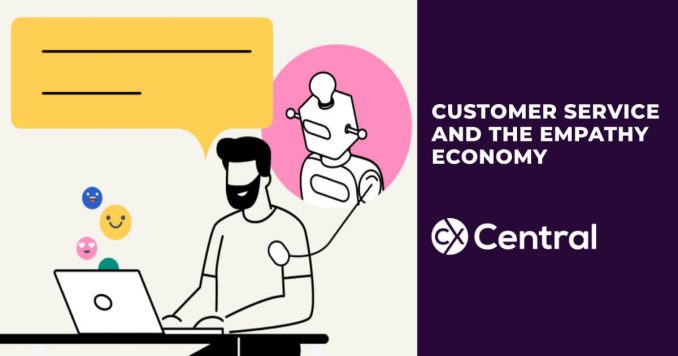
Customer service and the empathy economy
Excellent customer service is a vital tool in keeping your customers happy and, more importantly, loyal to your brand.
Yet as consumer expectations around direct contact with brands increases, the challenge to maintain high levels of customer satisfaction has never been more relevant.
Advances in conversational AI can prove a valuable tool in solving these rising demands from consumers, but they are not without their challenges.
Can a balance be struck that ensures brands benefit from these always-on channels without losing that all-important human touch and empathy required?
I sat down with digital and conversational AI experts Dave Flanagan from Genesys and our futurist from VERSA, Tomas Haffenden, to explore the role of empathy and a blended approach to AI and automated communications.
Empathy and prediction
Empathy is key to prediction, a vital element in the design and development of automated communications.
As Flanagan explained, “Empathy is about being human in how you engage with people as a business. It means having a conversation with a customer in the same way you would a friend or family member. You know your friends’ background, their experiences, their preferences and by using this information, you can predict and make suggestions because of your shared history”
With an integrated system that unifies all customer data points, past interactions and current context, it is possible to start building a more nuanced and empathic picture of the customer.
As Haffenden points out, “Bringing empathy to every interaction means understanding where that person came from, what their need is now and their preferred style of interaction. It is about building that relationship.”
Customers’ expectations continue to grow.
Haffenden and Flanagan agree massive growth in digital interactions and contact centre call volumes weren’t the only things to soar when the pandemic hit – customer expectations did too.
A part of that change in expectation is zero wait times and immediate solutions to complex problems.
“Most organisations have spent the last year focused on maximising efficiency and effectiveness. That is a great start, but it’s no longer enough. Adding new digital channels, AI capabilities, voice bots and chatbots is a great first step, but we’re starting to see a disconnect, and organisations need to refocus on the customer,” Flanagan said.
Although basic chatbots and voice bots can address the desired reduction in wait times, too often, there needs to be more consideration around how a bot can seamlessly hand over to a live agent capable of solving the more complex issues.
As Haffenden adds, “Customers will continue to engage at all times of the day on all channels, but most organisations still haven’t figured out how to connect the dots – how to deliver personalised, contextualised experiences across those channels.”
Indeed.
Gartner agrees, predicting by 2022, half of all large organisations will be stuck with disjointed and siloed CX that lack context because they have failed to unify engagement channels^^.
The switch to working from home – or “living at work”, as Haffenden calls it – has put even more pressure on organisations’ interactions with customers as consumer behaviour changes.
“The average commute in Sydney was 50 minutes pre-pandemic – that’s about 25 days over a year. The big question is, where are people spending that extra time? For many, it’s online. Most people have developed deeper online relationships, including companies that were once a separate part of their lives. That increased contact has increased expectations. Consumers will readily compare the experience they get from your business to the best in class CX they get from industry leaders like Apple or Adobe. They want fast and more detailed resolutions no matter what their issue is, and if they don’t get it from you, they’ll go find it elsewhere,” Haffenden said.
A blended approach is key.
So, if bots struggle with resolving complex bespoke issues and their human counterparts can be overwhelmed with volume, what is the solution?
Haffenden and Flanagan are both confident a solution is a blended approach that focuses on the automation of simple tasks like authentication and information gathering, with a seamless hand-off-to-human for those bespoke and complex tasks.
As Haffenden suggests,” A blended approach with seamless hand-off between a bot and a human will soon become the gold standard for best in class CX.”
This blended approach has already demonstrated its worth. Major telco Optus recently revealed its highest customer satisfaction scores from a blended customer experience combining human agents and AI, compared to using either in isolation.
“It’s an augmented customer experience, using AI to dial up the human aspect and freeing people to focus on more complex interactions,” HOF said.
Flanagan says it’s about identifying the “micro-moments”.
“It’s the moments where a little empathy can make a big difference. Maybe it’s predicting when a customer is struggling on your web site or app, so you can proactively engage and offer support. Maybe it’s using AI to connect that customer to the best human agent with the right skills to help with a particular issue. Or, it may be as simple as making a bot available 24/7 on all channels so if a customer has a query at 11 pm and your contact centre is closed, they can still get a quick and easy response.”
Context is key to empathy
It is possible to design more empathy into our bot interactions and script but context is key if you want to provide personalised empathic responses.
It’s what Haffenden calls ‘step zero’ when advising clients on their journey.
“Empathy and personalisation go hand in hand. You can’t define personalisation and the empathy required to answer a customer until you have explored the context in which those interactions are happening. An upfront discovery period to understand the landscape has to come before anything else,” he said.
“When you understand the context, you can create an interaction where there’s trust. For me, that’s about a reduction in repetition; authentication is a case in point. Many nonintegrated systems force a user to be authenticated multiple times during a single experience. This is a major problem if you are trying to provide top class CX.”
“The most significant opportunity to build trust and empathy is where you create interconnected systems where you can pass that background information to the relevant points to eliminate those annoyances and add value instead.”
“Customer service is an amazing example of that ability. If I call and do the automation and authentication once at the start of my journey before I arrive at a person with rich data to augment my experience – my last interaction, my website visits, anything to flag – it becomes a powerful experience. Perhaps it goes as far as AI recognising sentiment and suggesting appropriate responses to the agent in real-time – you’re close to a sale, give them an extra 5% to get them over the line. When that feedback loop goes full circle, everyone benefits.”
Even basic automation has a clear ROI
As cloud-based systems reduce price as a barrier to entry, more small to mid-sized businesses consider the trackable return on investment and improvements to CX that this technology can offer.
“Cloud has democratised AI services. They’ve become cheaper and easier to deploy and manage to the point where we see businesses with 20 support agents implementing it,” Flanagan said.
“The size (of your business) doesn’t matter. What matters is having an integrated approach to orchestrate experiences across the customer lifecycle and all channels, underpinned by AI capabilities.”
What’s next?
With Forrester predicting half of all contact centres will run in the cloud by 2022, and 70% will be using some form of AI the opportunity exists to make huge leaps forward.
But only for those ready to go all-in, Haffenden explained.
“A real shift has occurred in the past year as customers change their relationship with this technology. Higher customer satisfaction scores achieved with a blended approach clearly signal an acceptance of automation as part of the CX process. That opens the door to deeper automation opportunities and a more refined customer experience.”
Regardless of your current customer service set up these emerging technologies are going to play an increasingly central role.
Finding trusted partners that are capable of supporting both in terms of the logistics of cloud-based infrastructure and the implementation and integrations required to meet customer expectations is the first and most important step you need to take to stay ahead.
Helpful links
- Find suppliers: Search a list of industry suppliers of AI and Self-serve technology >
- Read: Empathy statements to use in customer service >
Sources:
- * Forester, Conversational AI Raised Efficiency but not CX During the Pandemic in Asia, Jan 21
- ** McKinsey Global Exec Survey Oct 2020 Aug 2020
- ^ Harvard Business Review, ‘Are you understanding your customers?’ January 2020
- ^^ Gartner – The Future of the Customer Engagement Center
- ^^^ Forrester: Customer Service Predictions 2021, IDC Futurescape

